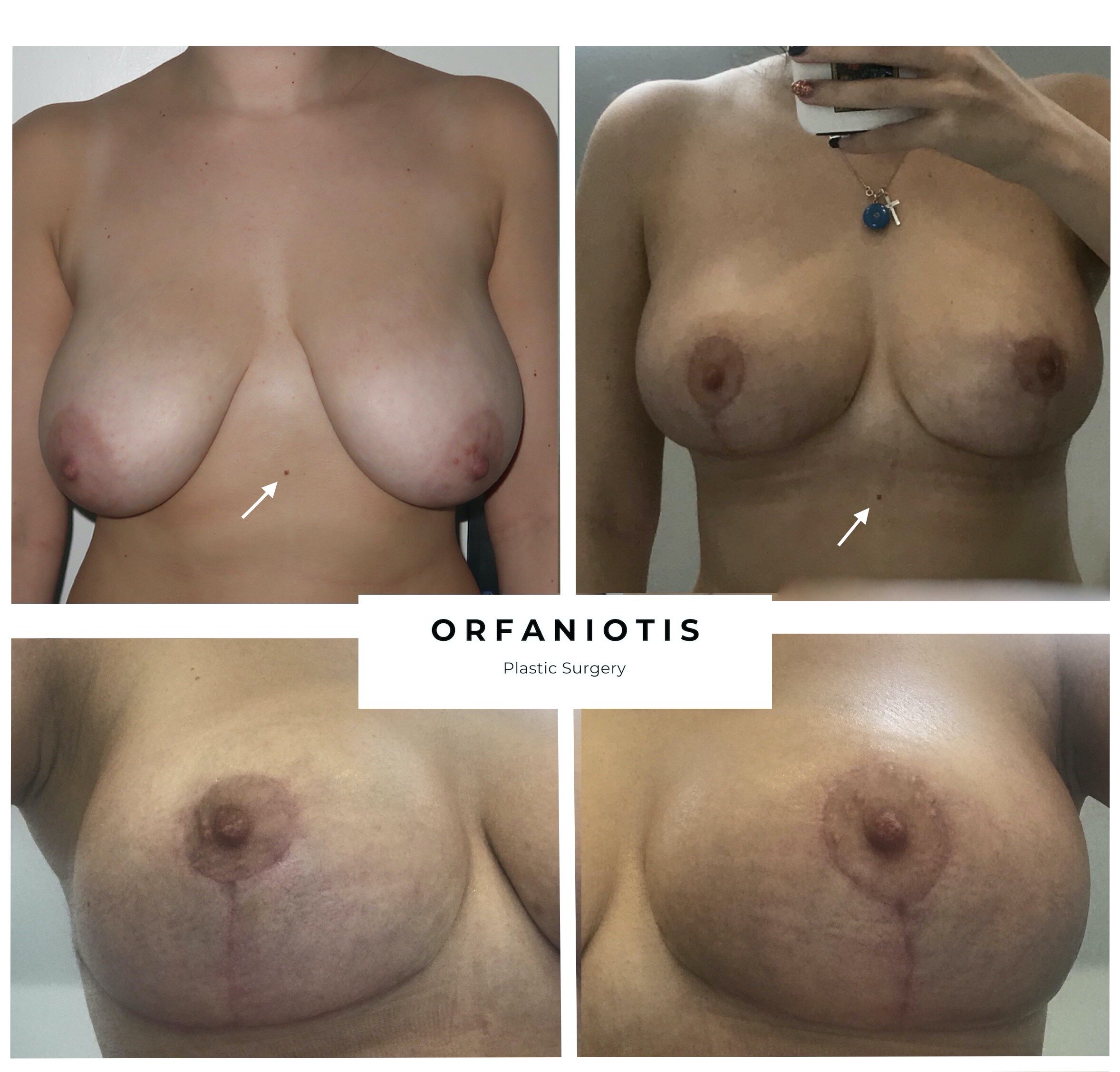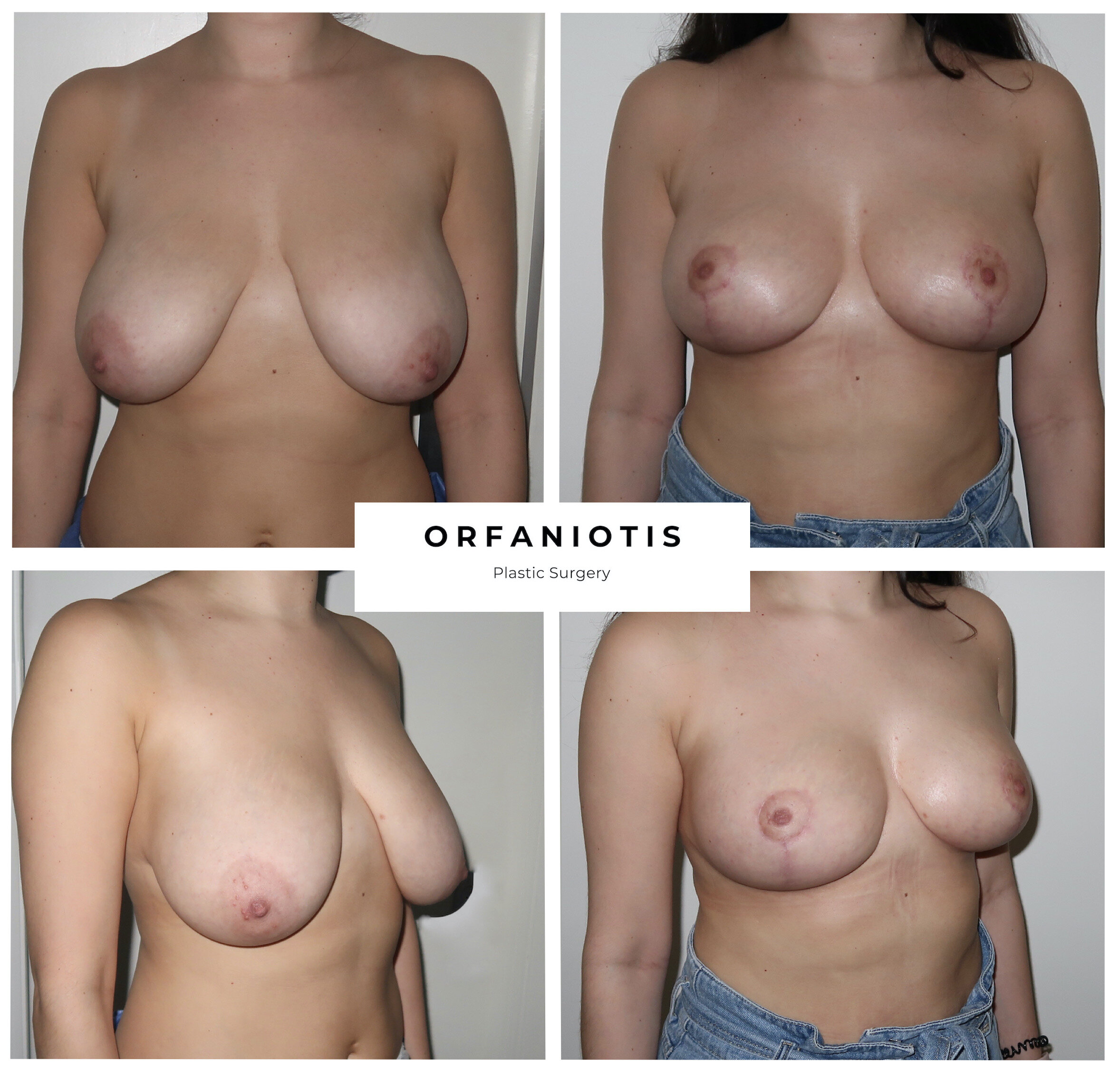Breast Lift with the Auto-Augmentation technique
What is a Mastopexy or Breast Lift?
Mastopexy or breast lift Is a surgical procedure which aims to improve the shape of the breast and achieve a more youthful perkier look. It involves removing excess skin and lifting the nipple and breast tissue to a more balanced and aesthetically pleasing position. Mastopexy is the recommended procedure for patients who have concerns with droopiness (also known as ptosis), and excess skin.
What causes breast ptosis (droopiness)?
Ptosis and excess skin are changes that occur due to loss of volume and/or loss of tissue support. This can be the result of pregnancies and breast feeding, the natural process of ageing, weight loss, or can even be congenital with presentation earlier in life.
Female breasts, like any other tissue part in the body, are subject to the ageing process. As we age, collagen and elastin production - the scaffolding structure of tissue, reduces. In women who have had children, have breastfed, or have lost a significant amount of weight, this process can be accelerated. Over time, these changes lead to sagging of the breasts - a process also known as ptosis. The nipple along with the majority of the breast tissue gradually drops below the level of the breast fold, leaving the ‘upper pole’ (upper half) empty. Ptosis is then further compounded by a loss of breast volume and excess skin. This loss of volume gives the appearance of a “deflated” breast with a variable amount of excess skin due to the loss of elasticity that comes with aging, and the inability of the skin to contract again.
How does a mastopexy differ from a breast reduction?
A breast reduction involves the removal of a significant amount of breast volume and weight. The primary aim of a Mastopexy however is not to reduce the volume of breast tissue, but rather to reshape the current breast volume into a better shape and position. Click here to read more about breast reduction surgery.
What technique does Mr Orfaniotis use for Mastopexy?
There have been several surgical techniques described for mastopexy surgery. Consideration of choice of technique needs not only an understanding of the immediate effect, but should ensure long lasting results. Mr Orfaniotis undertakes his Mastopexies using an Auto-augmentation technique.
What is the Auto-augmentation technique?
Auto-augmentation is an uplift technique, which uses the existing breast tissue to increase upper pole fullness, and create a perkier breast with no need for implants.
It consists of "splitting" the breast into 2 parts - Superior and inferior. The superior portion of breast tissue has the nipple attached to it, which is still connected to blood supply and nerves. The nipple/areola complex has been freed up and can now be easily mobilised into a higher position, ideally where the maximum projection of the breast will be.
The inferior, droopy part of the breast is also mobilised in order to be positioned and secured higher on the chest, in a pocket under the nipple and towards the cleavage area. This inferior portion acts like an implant with the difference that its the patient’s own tissue and hence described as “auto-augmentation”.
This technique can achieve an enhancement of an empty upper pole as well as create cleavage lines and projection. The breast is finally shaped with several layers of dissolvable stitches. The lower pole becomes tighter and the whole reshaped breast is lifted off the torso, giving the body a more youthful appearance.
What are the scars like with a Mastopexy?
Breast Lift Scars
Breast uplift- No implants.
3 month follow-up with patient selfie
Wise pattern (anchor) mastopexy with an Auto-augmentation technique = patient's own breast tissue is used to create upper pole fullness and cleavage lines
Arrows indicate a mole used as a reference point to show the degree of lift achieved.
A mastopexy is performed by introducing additional scars on the breast, which can be one of three types illustrated below.
The “donut” or circumareolar (scar around the nipple only), the “lollipop” or vertical pattern type (around the nipple and vertical line only), and the “anchor”, also known as inverted “T” or wise pattern (around the nipple, vertical line, and horizontal line in the fold).
The choice of the scar pattern will depend on the amount of excess skin and the degree of nipple lift required. Although the donut mastopexy gives the smallest amount of scarring, it is not effective when a significant lift is needed and hence and the least used in Mr Orfaniotis’ practice.
The two main indications for a donut mastopexy are:
When the primary goal of the procedure is to reduce the size of the Areola. Areola reduction surgery can be performed under local anaesthetic. A small degree of breast lift can also be achieved.
In patients who are having breast implants and suffer with small degree of ptosis.
For patients with the Auto-augmentation technique a full “anchor” scar is indicated. This enables better access and control of the breast tissue in order to deliver the best shape possible. The horizontal component is usually well-hidden in the fold and barely noticeable as you see in the picture below.
What If I need more volume?
For those patients who also have concerns about volume, a mastopexy can be combined with a breast enlargement procedure.
A volume increase can be achieved by either an implant or fat grafting. Click here to learn more about breast uplift with implants.
Case Examples with Online reviews
“Amazing Breast Lift Results!”
Feb 2021, Realself review
“I had a fantastic experience with George getting my breast uplift surgery.
From my first consultation with him I knew that I was in good hands as he was very informative, thorough and reassuring and gave me advice and guidance on the right size and shape for my body.
The procedure itself went very well and I am extremely happy with the results that he achieved. He took into consideration everything that I wanted, and was able to give me the perfect uplift with slight reduction to ensure I was left with a natural shape and size that suited my body (I am a slim size 10 so went from a disproportionately large 32E/F down to a 32D).
The recovery was a lot better than I thought it would be. Luckily I had no issues whatsoever, but whenever I felt anxious about something George would respond to my messages straightaway with advice and reassurance. I am now 3 months post op and I couldn't be happier with my results. I just wish I had got this done sooner!”
Amazing results and a wonderful experience!”
Nov 2020, Realself review
“I am currently 6 weeks post op for a Mastopexy with Dr Orfaniotis and the results have given me the confidence boost I really needed, I now feel much more comfortable in my skin. During my initial consultation; Dr. Orfaniotis was honest, friendly and gave me all the information I needed to make an informed decision on whether to go ahead with the procedure. Most importantly I felt totally comfortable around him.
The actual surgery went by without a hitch and the recovery was even smoother than I had expected. Now after 6 weeks I am healing really well and feel reassured in knowing that if I have any questions or any issues; I only need to call.
Dr. Orfaniotis is someone who truly cares about his patients and wants them to have the best results. I honestly couldn’t be happier with my experience.”
Mastopexy Details.
- First appointment: £150. No charge for 2nd consultation.
- Procedure Price: From £6800 - All inclusive price
- Follow-up: No charge, appointments up to 1 year.
- Duration: 2 - 2.5 hours.
- Anaesthetic: GA (fully asleep)
- Length of stay: Day case (Home the same day). Overnight stay option available.
- Drains: No drains
- Recovery: 7-10 days to return to work, 6 weeks to return to full activity
- Support bra to be worn for 6 weeks







